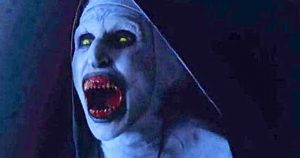Spoiler Warning for A Quiet Place: Day One
Sound design is arguably the most underrated element of film production today. While most everyday movie-enjoyers can understand and distinguish good acting and cinematography from the bad, it takes a little more finesse and purposeful viewing to appreciate how sound and music can subtly toggle a viewer’s emotion. A beautiful score and balanced auditory effects can elevate a decent film to a great one, and a great film to an iconic one.
This feature of movie-making is what came to define the 2018 horror-thriller hit A Quiet Place, a film that popularized the intentional absence of sound to heighten its impact. Taking place on an Earth invaded by deadly extraterrestrial creatures that rely exclusively on their hearing to hunt and slaughter humans, A Quiet Place became an instant classic with its memorable soundtrack, comprised of soft nature noises while lacking dialogue and punctuated by moments of terror. The film’s success, combined with consumers’ ravenous appetite for expanded universes of popular movies, led director John Krasinski to produce two continuations of the story—the 2020 sequel A Quiet Place Part II (2020) and, now, A Quiet Place: Day One (2024).
In a vacuum, A Quiet Place: Day One is decent. Unfortunately, as the third film in this franchise, it fails to justify its existence in any meaningful way. Fans who enjoyed the original’s horror elements and narrative themes will be satisfied by this prequel’s ability to invoke the same feelings and emotions that made its predecessor so popular. But without any significant innovation, it is more than likely that this film will soon be forgotten.
A Quiet Place: Day One’s biggest selling point is its drastic change in setting, which impressively subverts audience expectations for the franchise; whereas the original series took place in rural upstate New York many years into the world’s alien armageddon, this film takes us back in time to New York City in the namesake first days of the invasion. In the city, we follow Sam (Lupita Nyong’o), a terminally-ill cancer patient stranded in the quickly-crumbling city who is trying to avoid a grisly death. On her journey, she meets Eric (Joseph Quinn), a law student from England, and they slowly forge a bond for survival and companionship.
If the filmmakers’ goal was to paint a horrifying picture of what the beginning of the franchise’s alien invasion would look like in America’s biggest city, they definitely succeeded. Instead of showing the destruction of classic New York symbols, like the Empire State Building or Statue of Liberty, the film opts for scenes of ruined city streets and jarringly realistic screams of terror, creating a terrifying, yet authentic, tone. One of the most memorable scenes depicts Sam trying to navigate through a dust-cloud. Caked in thick, white dust that obscures her vision, screams of terror and confusion allude to the horrors and death surrounding her, but outside her field of view. Fear of the unknown is a potent tool for the horror genre, so relying heavily on the dust to obfuscate the viewer’s vision is an effective touch.
Another highlight of A Quiet Place: Day One is the relationship between Sam and Eric, which gives the film the heart it needs to keep the audience invested. Whereas the original A Quiet Place centered on familial love, this film evokes the same themes of devotion and sacrifice for loved ones from the romantic perspective. Despite being a horror-thriller, there are odd elements of a meet-cute that become evident upon watching Sam and Eric’s interactions. For instance, towards the end of the second act, the duo arrives in the ruined remains of a jazz club from Sam’s childhood and share drinks and food within—a peculiar yet welcome moment of levity in an apocalyptic world. Quality writing and, of course, Nyong’o and Quinn’s on-screen chemistry help sell the couple and prevent their relationship from feeling like a cheesy addition. Convincing the audience of the pair’s fondness for one another becomes imperative for the ending, when, much in the same way that the father (John Krasinski) in A Quiet Place gives up his life to save his children, Sam does the same to give Eric the opportunity to escape to safety. This act of ultimate sacrifice is well-executed and is likely to leave viewers with one or two tears.
Besides the effective change in setting and romantic shift, though, this film doesn’t offer much. For about 80% of the runtime, the film’s “thrill” is derived from the same jumpscares and chase scenes that have become standard for the franchise—it doesn’t make much of a difference that they’re happening in the subway system rather than a rural forest.
The film is also incredibly predictable, which impedes the viewer’s ability to sit in suspense. For example, before Eric, the film attempts to lead the viewer to believe that Sam will survive the apocalypse with her hospice nurse Reuben, since she is sheltered with him throughout the first act. Considering that all of the marketing for the film features Eric, it’s laughably easy to guess when Reuben is biting the dust.
There are other points as well where the director makes baffling decisions that derail the movie’s tone. At the film’s ending, after Sam has given up her opportunity to escape safely to save Eric (the obvious ending considering Sam’s terminal cancer), we see Eric reading Sam’s last note to him as she spends her final days in the city. It’s a heartbreaking scene knowing that the duo’s best outcome resulted in Sam’s tragic death. But the film doesn’t end on this somber tone. Instead, the film ends with a strange scene where Sam walks into the middle of a deserted street, rips out her headphones from a boombox, and blares Nina Simone’s “I’m Feeling Good,” drawing a monster’s deadly attention to her presumed demise. Cut to black—roll credits. After carefully building up a tragic tone throughout the film, this ending completely bungles it, making Sam’s death feel like more of a joke than a meaningful sacrifice. In this moment, the director completely overemphasized style over substance, likely leaving a sour taste in viewers’ mouths.
Like many films, A Quiet Place: Day One has its good moments and its bad moments, but its biggest sin is its inability to effectively innovate as the third film in its franchise. Sure, it has swapped out its characters and setting (more than can be said for A Quiet Place: Part II), but narratively and thematically, it is the same film that has already been released twice. If someone is looking for a solid summer thriller that has a little more meat to it than your average horror cash-grab, then A Quiet Place: Day One might be a good option. But for those expecting a film that recreates the magic of the 2017 original, unfortunately they’ll have to wait a little longer.





